In the depths of South Carolina’s waterways lies a mystery that has captivated archaeologists and history enthusiasts alike—the Chauga Mound. Submerged beneath the waters of the Tugaloo River in Oconee County, this ancient earthwork, dating back to the 12th century, is a testament to the rich Native American history of the region. Despite being concealed beneath the waves, the Chauga Mound continues to intrigue, with its secrets unfolding through the efforts of dedicated researchers.
The story of the Chauga Mound begins long before the waters of the Tugaloo River inundated its ancient structure. Built by the South Appalachian Mississippian culture in the 12th century, this platform mound reflects the architectural prowess of its builders. Similar to the Temple Mount at Ocmulgee National Monument in Georgia, the Chauga Mound once stood proudly on the banks of the Tugaloo River, a symbol of a vibrant and thriving indigenous community.
In 1962, the completion of the Hartwell Dam led to the Tugaloo River’s flooding, forever concealing the Chauga Mound beneath its waters. Despite the inevitable inundation, archaeologists seized the opportunity to study the site before its submersion. The investigations revealed that the mound was not just a standalone structure but a part of an ancient village with roots tracing back to the Middle Archaic period (8000 to 1000 BC).
The village surrounding the Chauga Mound may have been inhabited by indigenous peoples until the 18th century, with the possibility of Cherokee occupancy in its final years. The archaeological findings provided a glimpse into the daily lives, rituals, and burials of the people who once called this region home.
The Chauga Mound, like its counterparts in the Southeast, is a platform mound—a truncated pyramid with a flat top. Typically used for ceremonial or residential purposes, these mounds required the collaborative efforts of thousands of people who carried soil to construct the elevated structure. The design allowed structures to be perched high above the natural terrain, emphasizing their cultural significance.
Before the Mound was submerged, the Chauga Mound was explored by archaeologists. Over 60 graves were discovered within the mound, shedding light on the burial practices of the ancient community. Artifacts such as potsherds, tools, ornaments, and copper plates were found, believed to have been deposited as grave goods during burials. These findings provided invaluable insights into the material culture and customs of the indigenous peoples who once thrived along the Tugaloo River.
The Chauga Mound, now inaccessible beneath the Tugaloo River, remains one of the most perplexing archaeological sites in South Carolina. The challenge lies in preserving and studying the site for future generations. The submerged Chauga Mound invites us to question the untold stories and cultural richness that may forever remain out of reach.
As we uncover the history of Anderson, SC, the submerged Chauga Mound stands as a reminder of our region’s indigenous peoples. Despite the challenges of preservation and accessibility, the mysteries of this underwater earthwork continue to fuel the curiosity of historians and archaeologists alike.
This blog post is inspired by the article “The Under Water Earthwork In South Carolina That Still Baffles Archaeologists To This Day” by Robin Jarvis, published on June 25, 2022.







